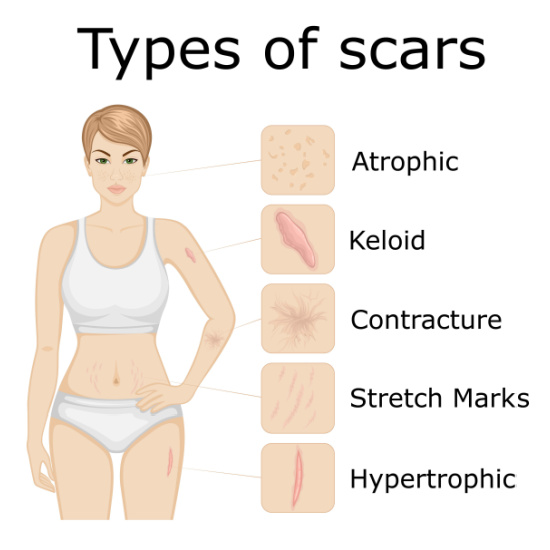
Do you have a thick, raised, claw-like scar that feels rubbery and doesn't stop growing? You may have a keloid scar if you have darker skin, are under 30, or have family members who suffer from the same condition. A board-certified surgeon can remove these unsightly, painful scars using several methods:
Here at Avana Wellness Plus, we will care for your plastics, cosmetics, and medical needs to the highest degree of medical excellence. Under our experienced care, you can have confidence that we comprehend the intricacies of keloids, a distressing and disfiguring issue. We work with the best in Miami because our number one goal is to provide exceptional care. Once you have stepped out of our operating room, we will put you in touch with the best professionals in Miami to help you continue to manage your keloids to the highest level of medical expertise.
Restore your flawless skin with keloid removal at Avana Wellness Plus. Call now for a free consultation with Miami's best experts!
A keloid is a scar that won't stop growing. It is benign and is not contagious, and won't cause cancer. These scars are caused by trauma to the skin. Any trauma can cause a keloid to form or grow, including cuts, burns, acne, injections, piercings, and even simple bumps. Women have even reported seeing them appear spontaneously on their busts!
Typically, keloids only form where there is already a scar (or a new spot is starting). They do not form on normal skin. Keloids cause much pain and discomfort because they can grow anywhere on the body--including the earlobes, chest, shoulders, back, and collarbone -where they can get caught on clothes or bump into corners, only to cause more injury and continue growing. The pain associated with keloids is physical, neurological, and emotional. Keloids can experience indefinite growth, and they can multiply. These problems don't go away without surgical and medical treatment.

Because Keloids can appear anywhere on the body after an injury to the skin, they have great potential for adverse effects, and removal through surgery can substantially improve a person's quality of life. The benefits of keloid removal are clear. By removing a keloid, you can:

Discover the Ultimate Fusion of Wellness and Beauty in Miami area.
Contact Our TeamThere are several ways to remove keloids. The larger, more burdensome keloids can be surgically excised only with additional laser, corticosteroids, or radiation treatment to prevent returns.
Surgical removal is used for large keloids in delicate areas such as the face, earlobes, and female bust. A board-certified plastic or cosmetic surgeon should remove keloids that grow in these areas where symmetry and aesthetics significantly preserve the natural beauty of the patient's features.
Post-operative care will be targeted at preventing the keloid from coming back and will include the following steps:
No downtime is associated with this procedure, and only local anesthesia is used. In exceptional instances, the removal of particularly large keloids may necessitate the use of general anesthesia. Patients are typically delighted with surgical excision for treating keloids when used with the additional recommended treatment beyond the operating room. Pain is minimal at the treatment site and is well-managed with over-the-counter medications.
At Avana Wellness Plus, our board-certified cosmetic and plastic surgeons will create a post-operative plan of care that will include recommendations for top-of-the-line treatments targeting keloid regrowth beyond the operating room. We may refer you to an area specialist to complete your therapy once the excision is complete. It will depend on the complexity of your case. At Avana Wellness Plus, our surgical plan always prioritizes your medical outcomes.
Laser treatment is a newer technique for treating keloid scars, and several different types of lasers are available for therapeutic use
Pulsed Dye Laser Therapy
Pulsed dye lasers target scarring. By getting rid of the scar, you stop the keloid from growing. Pulsed dye lasers use light to shrink and dissolve scar tissue. They can reduce redness and discoloration in a scar, making it less visible to the naked eye because it blends more easily with the surrounding skin. Over several sessions, a pulsed dye laser can remove whatever is left over from a scar after removing a keloid. After the initial surgical excision, several sessions may be needed to remove whatever is left from the cicatrix. The procedure has few side effects. A small amount of bruising may occur around the scar; this will fade within a few days.
Fractional Laser Therapy
Another type of laser therapy that you may pursue after surgical excision is fractional laser therapy. Using light, this laser hits tiny sections of scarred skin, one at a time, causing each section to exfoliate. This method of highly targeted exfoliation removes whatever remains of the scar after the excised keloid. The scar tissue is removed without affecting healthy skin and, therefore, causes no new trauma.
The benefit of using this type of laser is that your skin will heal faster, lowering the likelihood of keloids coming back. The lack of additional trauma while removing the scar tissue minimizes the risk of keloid regrowth. Multiple treatments may be necessary. Skin specialists typically recommend 6-8 sessions per year. After the laser treatment, a specialist will bandage the area. Within a week, a thin layer of skin will peel off, and you may experience swelling, redness, and itching. You prevent infection by keeping your skin moisturized and clean. Avoid the sun. Apply SPF of at least 30.
Steroids help prevent the regrowth of a keloid after surgical excision. They are injected directly into the tissue to shrink it because steroids destroy collagen, which makes the keloid tissue grow. Steroids are also anti-inflammatory and treat the pain and discomfort caused by keloids, such as:
After the injection, your surgeon will massage the area to increase the effectiveness of the steroid. The process takes 15 minutes, and the injection itself requires no anesthesia. If a keloid does return after surgery, we recommend returning for steroid injections every 4 to 6 weeks for no more than five injections. This extended management usually occurs with your primary care doctor or dermatologist.
Low-dose radiation therapy is an alternative keloid treatment, using X-rays to target and eliminate the collagen-producing cells. Collagen is what makes keloids grow. Radiography is pain-free, and your surrounding skin will be protected from X-rays. It takes less than 10 minutes. After the procedure, the area will be bandaged and protected from infection and the sun.
Side effects of this type of therapy are minimal and include redness and some tenderness at the targeted site. This type of therapy may be recommended if your keloids do not respond to more traditional methods or if your keloids have expanded considerably. You should complete radiotherapy within two days after keloid excision to minimize the risk of regrowth.

Keloids are susceptible because medical and surgical issues cause aesthetic, medical, and emotional dysfunction. We recommend that a board-certified plastic or cosmetic surgeon surgically excise all large keloids. Additionally, excision therapy should be accompanied by additional treatment beyond the operating room to prevent the keloid from returning. It ensures the best medical and aesthetic outcomes, particularly in delicate areas of the body such as the face, earlobes, and bust, where symmetry and aesthetics are essential.
With the many therapeutic options available for keloid removal--and the many ways to combine them--the treatment approach will come down to a collaboration between you and your board-certified surgeon or doctor of choice. Avana Wellness Plus is committed to offering every patient a personalized treatment plan designed to suit their needs and concerns.
Surgical keloid removal in Miami ranges from $500 to $1,800. It depends on keloid size, the number of keloids, the combination of treatments chosen, and the doctor's experience.
Individuals with good health and realistic expectations make suitable candidates for keloid removal.
We employ cutting-edge and dependable techniques to remove keloids while minimizing scarring effectively. Since keloid treatments frequently involve the earlobes, the surgeon must uphold symmetry and restore the earlobe's natural appearance. As no two keloids are made equal, each treatment for keloid removal is unique and requires the artistic skill of the surgeon. While keloid removal is a relatively simple procedure, there are risks of producing aesthetically unpleasing results, and we minimize those risks here at Avana Wellness Plus due to our extensive expertise and board-qualified cosmetic and plastic surgeons.
In the majority of cases, only local anesthesia is necessary. For highly extensive procedures, intravenous sedation can be administered during outpatient keloid surgery.
It usually takes less than an hour to complete the keloid removal procedure performed in the office.
Keloid Removal procedures include surgical keloid removal and laser therapy for larger keloids. For smaller keloids, Steroid injection treatment is suggested.
Unfortunately, keloids have a well-known tendency to reappear following treatment. Hence, it is crucial to choose a doctor with significant expertise and diligently adhere to the post-treatment instructions provided by your healthcare provider.
Recovery durations can differ among patients, and as a result, the keloid surgeon will engage in individual discussions with each patient to determine the expected recovery time and when it's safe to resume regular work or daily routines. Nonetheless, most patients can return to work and their normal activities within the following day.
Feel free to reach out to us, and we'll get in touch with you shortly.